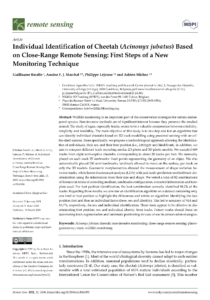
Baralle G., Marchal A. F. J., Lejeune P., Michez A. [2021] Individual Identification of Cheetah (Acinonyx jubatus) Based on Close-Range Remote Sensing: First Steps of a New Monitoring Technique. Remote Sens., 13, 1090. https://doi.org/10.3390/rs13061090
Abstract : Wildlife monitoring is an important part of the conservation strategies for certain endangered species. Non-invasive methods are of significant interest because they preserve the studied animal. The study of signs, especially tracks, seems to be a valuable compromise between reliability, simplicity and feasibility. The main objective of this study is to develop and test an algorithm that can identify individual cheetahs based on 3D track modelling using proximal sensing with an off-the-shelf camera. More specifically, we propose a methodological approach allowing the identification of individuals, their sex and their foot position (i.e., left/right and hind/front). In addition, we aim to compare different track recording media: 2D photo and 3D photo models. We sampled 669 tracks from eight semi-captive cheetahs, corresponding to about 20 tracks per foot. We manually placed on each track 25 landmarks: fixed points representing the geometry of an object. We also automatically placed 130 semi-landmarks, landmark allowed to move on the surface, per track on only the 3D models. Geometric morphometrics allowed the measurement of shape variation between tracks, while linear discriminant analysis (LDA) with jack-knife prediction enabled track discrimination using the information from their size and shape. We tested a total of 82 combinations of features in terms of recording medium, landmarks configuration, extracted information and template used. For foot position identification, the best combination correctly identified 98.2% of the tracks. Regarding those results, we also ran an identification algorithm on a dataset containing only one kind of foot position to highlight the differences and mimic an algorithm identifying the foot position first and then an individual factor (here, sex and identity). This led to accuracy of 94.8 and 93.7%, respectively, for sex and individual identification. These tools appear to be effective in discriminating foot position, sex and individual identity from tracks. Future works should focus on automating track segmentation and landmark positioning for ease of use in conservation strategies.
Consultez la notice complète de l’article sur ORBi
